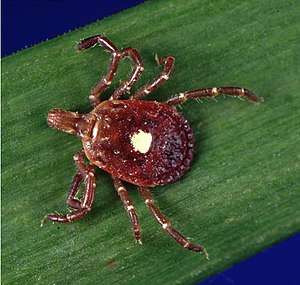Hyalomma dromedarii
Hyalomma dromedarii is a species of hard-bodied ticks belonging to the family Ixodidae.[1]
| Hyalomma dromedarii | |
|---|---|
| Hyalomma dromedarii from Libya. Museum specimen | |
| Scientific classification | |
| Kingdom: | |
| Phylum: | |
| Class: | |
| Subclass: | |
| Superorder: | |
| Order: | |
| Family: | |
| Subfamily: | Hyalomminae |
| Genus: | |
| Species: | H. dromedarii |
| Binomial name | |
| Hyalomma dromedarii C. L. Koch, 1844 | |
| Synonyms | |
| |
Description
The dorsal shield (conscutum) of males can reach a length of 3.7–5.78 millimetres (0.146–0.228 in). These hard-bodied ticks are broadly oval in shape.The basic color is yellow- to red-brown.[2]
This species is closely associated with camels, that are the main hosts of the adults, which may also parasitize other domestic animals. Nymphs and larvae are associated with the same hosts, but can also parasitize rodents, hedgehogs and birds.[2]
This species is ascribed with spreading the virus that causes the life-threatening Crimean-Congo hemorrhagic fever.[3] The bites cause the surrounding tissue to die and become necrotic. The dead tissue falls out of the body after a few days. The wounds look very serious, but usually heal without any intervention and do not generally become infected any further.
Distribution
Hyalomma dromedarii is widespread in North Africa, the northern regions of West, Central, and East Africa, Arabia, Asia Minor, the Middle East, and Central and South Asia.[2]
References
- Biolib
- DMITRY A. APANASKEVICH, ANTHONY L. SCHUSTER AND IVAN G. HORAK The Genus Hyalomma : VII. Redescription of all Parasitic Stages of H.(Euhyalomma) dromedarii and H. (E.) schulzei (Acari: Ixodidae)
- Logan TM, Linthicum KJ, Bailey CL, Watts DM, Dohm DJ, Moulton JR Replication of Crimean-Congo hemorrhagic fever virus in four species of ixodid ticks (Acari) infected experimentally
- A. ELGhalia, S.M. Hassanb Life cycle of the camel tick Hyalomma dromedarii (Acari: Ixodidae) under field conditions in Northern Sudan
